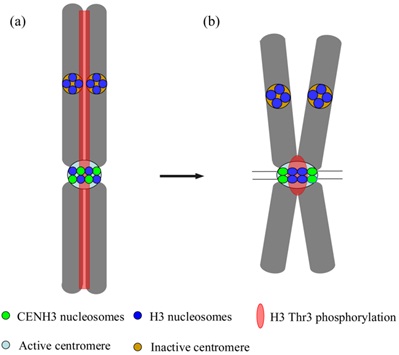Histone phosphorylation was reported previously to be involved in the establishment and maintenance of functional centromeres and was related to the dynamic chromosome behavior during the cell cycle. However, it was largely unknown the role of histone phosphorylation on chromosome orientation and segregation in plants.
In order to understand these mechanisms in plants, Dr. HAN Fangpu’s lab in the Institute of Genetics and Developmental Biology (IGDB), Chinese Academy of Sciences, has focused on histone H2A and H3 phosphorylation and the relationship with chromosome orientation and segregation during the cell cycle in maize and wheat since 2010. They first discovered that phosphorylation of histone H2A on threonine 133 was an epigenetic marker for functional plant centromeres (Dong and Han. 2012). The localization of kinase Bub1 and the dynamic distribution of phosphorylated H2AThr133 during mitosis revealed temporal and spatial regulatory roles for H2A phosphorylation during chromosome segregation (Su et al. 2017).
Recently, Dr. HAN’s group is working on the mechanism of H3T3 phosphorylation with regard to chromosome dynamic changes and the relationship with centromere activity in maize. Through a detailed cytological observation on wild type and meiosis specific mutants of maize, they found that dynamic distribution of histone H3T3 phosphorylation during mitosis and meiosis is approximately parallel to the cohesion dynamic changes during the cell cycle.
The researchers are also studying whether H3T3 phosphorylation occurred in inactive centromeres. They found that phosphorylation occurred in prophase of mitosis in the inactive centromere (Figure a). However, centromeric localization of H3T3ph required functional centromeres at metaphase. Interestingly, they found that CENH3 and H3T3ph occupy different domains in the centromere at prophase and H3T3ph changes position from the pericentromere to the inner centromere in the process of chromosome movement to the equatorial plate at metaphase (Figure b), which may be required to keep the tension between sister chromatids and promote bi-orientation of sister chromatids.
The work entitled “Cohesion and Centromere Activity Are Required for Histone H3 Phosphorylation in Maize” was published in
The
Plant Journal October 16, 2017 (
DOI:10.1111/tpj.13748).
This work was supported by grants from the by National Natural Science Foundation of China (31320103912 and 31630049) and National Science Foundation Plant Genome grant (IOS-1444514).
Figure: Model of dynamic distribution of Histone H3T3 phosphorylation on a chromosome from prophase to metaphase. (Image by IGDB)
Contact:
Dr. HAN Fangpu
Email: fphan@genetics.ac.cn
 Figure: Model of dynamic distribution of Histone H3T3 phosphorylation on a chromosome from prophase to metaphase. (Image by IGDB)Contact:Dr. HAN FangpuEmail: fphan@genetics.ac.cn
Figure: Model of dynamic distribution of Histone H3T3 phosphorylation on a chromosome from prophase to metaphase. (Image by IGDB)Contact:Dr. HAN FangpuEmail: fphan@genetics.ac.cn CAS
CAS
 中文
中文




.png)
